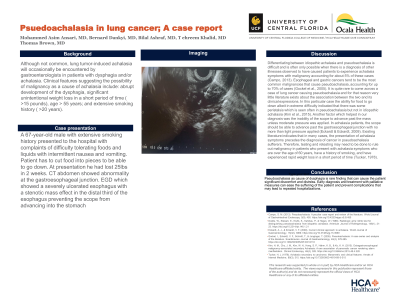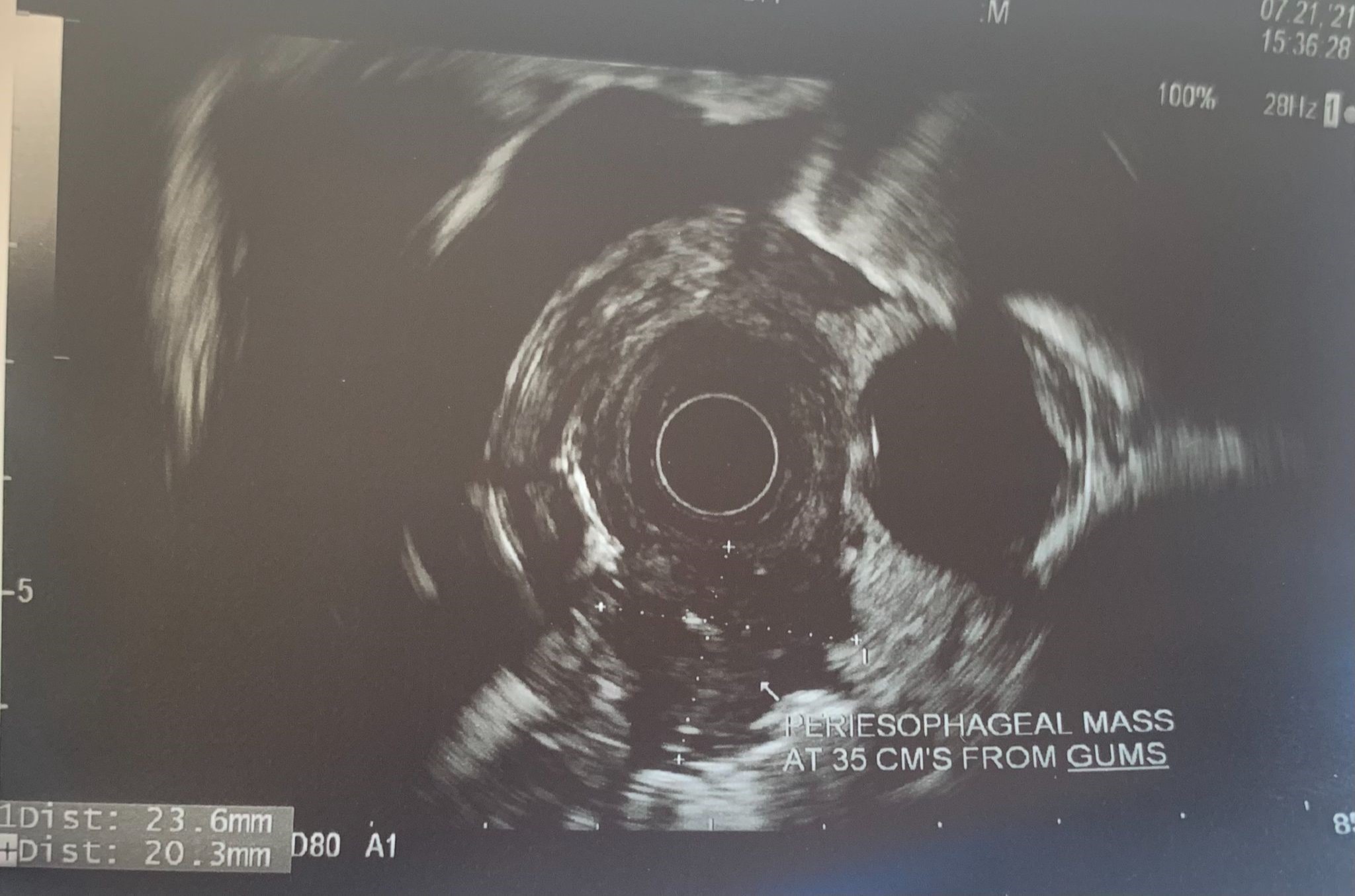Back


Poster Session D - Tuesday Morning
Category: Esophagus
D0244 - Pseudoachalasia in Lung Cancer
Tuesday, October 25, 2022
10:00 AM – 12:00 PM ET
Location: Crown Ballroom

Has Audio
- MA
Mohammed Ansari, MD
HCA/UCF Ocala Regional Medical Center
Ocala, FL
Presenting Author(s)
Mohammed Ansari, MD1, Bernard Dankyi, MD2, Bilal Ashraf, MD1, Tehreem Khalid, MD2
1HCA/UCF Ocala Regional Medical Center, Ocala, FL; 2UCF College of Medicine-HCA GME Consortium/HCA Florida Ocala Hospital, Ocala, FL
Introduction: Although not common, lung tumor-induced achalasia will occasionally be encountered by gastroenterologists in patients with dysphagia and/or achalasia. Clinical features suggesting the possibility of malignancy as a cause of achalasia include: abrupt development of the dysphagia, significant unintentional weight loss in a short period of time ( >15 pounds), age > 55 years; and extensive smoking history ( >20 years).
Case Description/Methods: A 67-year-old male with extensive smoking history presented to the hospital with complaints of difficulty tolerating foods and liquids with intermittent nausea and vomiting. Patient has to cut food into pieces to be able to go down. At presentation he had lost 25lbs in 2 weeks. CT abdomen showed abnormality at the gastroesophageal junction. EGD which showed a severely ulcerated esophagus with a stenotic mass effect in the distal third of the esophagus preventing the scope from advancing into the stomach
Discussion: Differentiating between idiopathic achalasia and pseudoachalasia is difficult and is often only possible when there is a diagnosis of other illnesses observed to have caused patients to experience achalasia symptoms with malignancy accounting for about 5% of these cases (Campo, 2013). Esophageal and gastric cancers tend to be the most common malignancies that cause pseudoachalasia, accounting for up to 70% of cases (Gockel et al., 2005). It is quite rare to come across a case of lung cancer causing pseudoachalasia and for that reason very little literature exists about the association between the two and its clinical expressions. In this particular case the ability for food to go down albeit in extreme difficulty indicated that there was some peristalsis which is seen often in pseudoachalasia but not in idiopathic achalasia (Kim et al., 2015). Another factor which helped in our diagnosis was the inability of the scope to advance past the mass unless moderate pressure was applied. In achalasia patients, the scope should be able to advance past the gastroesophageal junction with no more than light pressure applied (Eckardt & Eckardt, 2009). Existing literature indicates that in many cases, the presentation of achalasia symptoms precedes the diagnosis of cancer in pseudoachalasia sufferers. Therefore, testing and retesting may need to be done to rule out malignancy in patients who present with achalasia symptoms who are over the age of 60 years, have a history of smoking, and have experienced rapid weight loss in a short period of time (Tucker, 1978).

Disclosures:
Mohammed Ansari, MD1, Bernard Dankyi, MD2, Bilal Ashraf, MD1, Tehreem Khalid, MD2. D0244 - Pseudoachalasia in Lung Cancer, ACG 2022 Annual Scientific Meeting Abstracts. Charlotte, NC: American College of Gastroenterology.
1HCA/UCF Ocala Regional Medical Center, Ocala, FL; 2UCF College of Medicine-HCA GME Consortium/HCA Florida Ocala Hospital, Ocala, FL
Introduction: Although not common, lung tumor-induced achalasia will occasionally be encountered by gastroenterologists in patients with dysphagia and/or achalasia. Clinical features suggesting the possibility of malignancy as a cause of achalasia include: abrupt development of the dysphagia, significant unintentional weight loss in a short period of time ( >15 pounds), age > 55 years; and extensive smoking history ( >20 years).
Case Description/Methods: A 67-year-old male with extensive smoking history presented to the hospital with complaints of difficulty tolerating foods and liquids with intermittent nausea and vomiting. Patient has to cut food into pieces to be able to go down. At presentation he had lost 25lbs in 2 weeks. CT abdomen showed abnormality at the gastroesophageal junction. EGD which showed a severely ulcerated esophagus with a stenotic mass effect in the distal third of the esophagus preventing the scope from advancing into the stomach
Discussion: Differentiating between idiopathic achalasia and pseudoachalasia is difficult and is often only possible when there is a diagnosis of other illnesses observed to have caused patients to experience achalasia symptoms with malignancy accounting for about 5% of these cases (Campo, 2013). Esophageal and gastric cancers tend to be the most common malignancies that cause pseudoachalasia, accounting for up to 70% of cases (Gockel et al., 2005). It is quite rare to come across a case of lung cancer causing pseudoachalasia and for that reason very little literature exists about the association between the two and its clinical expressions. In this particular case the ability for food to go down albeit in extreme difficulty indicated that there was some peristalsis which is seen often in pseudoachalasia but not in idiopathic achalasia (Kim et al., 2015). Another factor which helped in our diagnosis was the inability of the scope to advance past the mass unless moderate pressure was applied. In achalasia patients, the scope should be able to advance past the gastroesophageal junction with no more than light pressure applied (Eckardt & Eckardt, 2009). Existing literature indicates that in many cases, the presentation of achalasia symptoms precedes the diagnosis of cancer in pseudoachalasia sufferers. Therefore, testing and retesting may need to be done to rule out malignancy in patients who present with achalasia symptoms who are over the age of 60 years, have a history of smoking, and have experienced rapid weight loss in a short period of time (Tucker, 1978).

Figure: EUS showing the periesophageal mass.
Disclosures:
Mohammed Ansari indicated no relevant financial relationships.
Bernard Dankyi indicated no relevant financial relationships.
Bilal Ashraf indicated no relevant financial relationships.
Tehreem Khalid indicated no relevant financial relationships.
Mohammed Ansari, MD1, Bernard Dankyi, MD2, Bilal Ashraf, MD1, Tehreem Khalid, MD2. D0244 - Pseudoachalasia in Lung Cancer, ACG 2022 Annual Scientific Meeting Abstracts. Charlotte, NC: American College of Gastroenterology.
